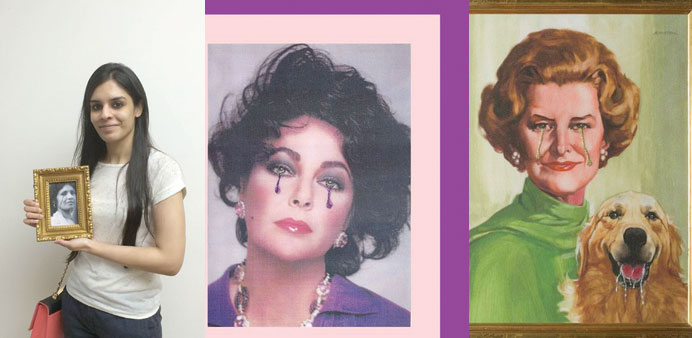PUTTING ON A BRAVE FACE: Zareen Akhtar, winner of the Fame Project competition, with her exclusive portrait done by Vezzoli; right, the enlarged portrait. RIGHT: Elizabeth Taylor and Betty Ford
By Anand Holla
Sparkling pop culture icons, built and consumed by fame, were seen weeping embroidered — and glittering — tears in Italian artist Francesco Vezzoli’s much-acclaimed Museum of Crying Women exhibition, end of last year.
Vezzoli chose Doha’s Qatar Museums (QM) Gallery at Katara for the exhibition, his first in the Middle East, and his works compelled visitors to identify with the characters in the portraits on a deeply personal level.
This week, with the QM announcing the winner of the Fame Project competition, the idea behind Vezzoli’s works that urged people to reflect on the drama of their own divided identity has come full circle.
Vezzoli not only explored the painful private lives that lie behind famous female personalities, but his interpretations of their portraits also suggested that personal hardships have only strengthened them.
Inspired by that thought, the competition was thrown open to the women in Qatar to share their struggles, pain and eventual triumph in their personal stories. The winner was to get her portrait done by Vezzoli himself, which also spelt a rare opportunity to own an exclusive Vezzoli artwork. Of the 35 stories that QM received, 10 were shortlisted for public voting and eventually one winner, Zareen Akhtar, was chosen.
Akhtar’s winning story — which the QM couldn’t share due to privacy reasons — resonated most with the voters, and gained a total of 337 votes. She has now received an exclusive portrait of herself created by Vezzoli himself.
It came as no surprise that the competition was open only for women since the exhibition celebrated femininity in its most adored form, by delving into the personalities of fashion icons, first ladies, and Hollywood stars.
Vezzoli’s thought-stirring portraits featured every powerful female celebrity from Elizabeth Taylor to Lady Gaga, Joan Crawford to Betty Ford, questioning the authenticity of life in the spotlight.
By mixing found photographs, magazine covers, embroidery and needleworks, Vezzoli managed to spot sadness and anguish on the crossroads of the celebrities’ personal and public lives, and translated it in fine style.
The two dripping tears on Taylor’s glamourous portrait, for instance, matched with the colour of her glitzy purple top. Taylor, who married eight times and underwent 100 operations, once described herself as a “living example of what people can go through and survive.”
She battled skin cancer, a brain tumour, diabetes, seizures, a stroke, and chronic back problems that led to painkiller and alcohol addiction, throughout her six-decade film career of 50 movies. But the woman never gave up, and her story has inspired millions.
A series of portraits of renowned Arab singer Oum Kalthoum with one tear cutting across her face, built mostly around various magazine covers, was the highlight of the exhibition. Titled You Who Enjoyed My Tears, Kalthoum’s hall of fame took centre stage.
The Egyptian vocalist, in her time, was the most influential woman in the Middle East and yet her personal life wasn’t rosy. She lost her true love and her marriage lasted only a few days, but her love affair with music spurred her on to dedicate her life to the arts.
Two tears were introduced into former first lady Betty Ford’s smiling portrait while a drooling dog sat next to her. Ford went public with her breast cancer, alcoholism and drug addiction, and inspired millions to seek help for the first time.
Gaga’s visage was placed on a painting of a bust of Minerva, the Roman idol of the arts. Using metallic thread, Vezzoli attached images from a Giorgio de Chirico painting that were stretched into weird-looking teardrops. This was to suggest that though Gaga enjoyed fame, she also has been relegated to a stationary object.
Tears weren’t drawn on Italian actress Silvana Mangano’s portrait though. Re-imagined as Mary Magdalene, Vezzoli stuck two needles over her eyes to suggest a hint of tears that indicate sadness that’s perhaps too private.
Vezzoli, as reported by the Gulf Times during the opening of his exhibition, had said, “I am not interested in the history of politicians but I am more interested in history of emotions. In many parts of the world, women used to engage in needle work which, for me, is an emotional painting. It is a counter part for their public identity. The private persona has emotions and those emotions are expressed in private. The tears represent those emotions. The tears represent all such atrocities around the world which we generally do not see.”
Marked by a distinct style, Vezzoli’s art is known for being a thorough study and a continuous homage to the world of art and cinema, and to its many iconic figures. By drawing inspiration from biographies and essays of historical figures, Vezzoli’s works include video installations and petitpoint embroideries, mixing heterogeneous languages and genres, bringing together pop icons, auteur cinema, art history, political and private issues.
The Museum of Crying Women exhibition, which also included a bronze sculpture of Sophia Loren, was created in partnership with Vezzoli, Hans-Ulrich Obrist (Co-Director of Exhibitions and Programmes and Director of International Projects at the Serpentine Gallery, London) and Rem Koolhaas (Founder of architecture firm OMA), and remains among QM’s most celebrated exhibitions till date.

